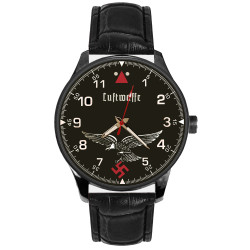No products
Luftwaffe Swastika Eagle Emblem WW-II Germany Solid Brass Collectible Watch
LUFT-03
New product
- 40 mm heavy brass case, genuine leather strap
- premium Japanese quartz movement, long-lasting LR44 battery
- handmade pinewood souvenir box with SS decal
- original metallic 2D art custom-made dial
More info
The Second World War saw the extensive use of military-issued timepieces, and Germany was no exception. The watches issued to German forces, including the Wehrmacht, Luftwaffe, Kriegsmarine, and especially the SS and Waffen-SS, were not merely functional accessories but also played a role in military precision and propaganda.
The Role of Watches in WWII Germany
Timekeeping was crucial in military operations, with watches used for coordination, navigation, and mission execution. The German military relied on several watch manufacturers to supply high-precision timepieces to its forces. Unlike Allied forces, where brands like Rolex and Omega were prominent, Germany turned to manufacturers such as A. Lange & Söhne, Junghans, Stowa, and Laco to produce functional, high-quality watches.
In particular, the Dienstuhr (Service Watch) was a standard-issue timepiece provided to German soldiers. These watches were often simple, highly legible, and designed for rugged field conditions. The most iconic military watches of Nazi Germany include:
-
Beobachtungsuhren (B-Uhren) – Large, highly accurate watches used by Luftwaffe navigators.
-
Kriegsmarine Watches – Water-resistant timepieces used by the German Navy.
-
Dienstuhr der Wehrmacht – Standard service watches for ground troops.
However, it was within the elite divisions like the SS and Waffen-SS where watches took on a more symbolic role, entwined with Nazi propaganda.
Watches of the SS and Waffen-SS
The Schutzstaffel (SS) and its armed branch, the Waffen-SS, represented Hitler’s elite military forces. The SS was deeply involved in the ideological and operational aspects of the Nazi regime, and its members were often equipped with superior gear, including watches.
While the SS did not have an official issued timepiece, SS officers often had access to high-quality watches from German and Swiss brands. Some known examples include:
-
A. Lange & Söhne – The company manufactured high-precision watches for the German military, with some models associated with SS officers.
-
Tutima and Hanhart Chronographs – These were popular among Luftwaffe and SS officers due to their precise timekeeping, which was crucial for pilots and strategists.
-
Longines, IWC, and Glashütte – Some SS personnel purchased or requisitioned these Swiss and German-made watches.
SS watches were typically adorned with engraved runes, Nazi symbols, or unit markings, reinforcing the elite status of the wearer. Some pocket watches issued to SS members had inscriptions such as “Meine Ehre heißt Treue” (My Honor is Loyalty), the motto of the SS.
The Propaganda Behind SS and Waffen-SS Watches
Propaganda played a massive role in Nazi Germany, influencing every aspect of military and civilian life, including the symbolism surrounding personal items like watches. Watches became both practical tools and ideological statements.
-
Symbol of Superiority: The SS cultivated an image of being an elite, disciplined force. Their watches, often more sophisticated than those issued to regular Wehrmacht troops, symbolized their superior status within the Nazi hierarchy.
-
Nazi Branding: Some SS watches and accessories featured swastikas, Totenkopf (Death’s Head) insignias, and runic symbols to reinforce their identity and ideology.
-
Gifts and Rewards: Higher-ranking SS officers sometimes received watches as awards for service. Hitler and Heinrich Himmler were known to distribute luxury watches to their most loyal SS personnel.
-
Use in Propaganda: Nazi propaganda often depicted SS officers wearing polished, high-quality watches in recruitment materials and posters, reinforcing their image of professionalism and power.
The Fate of SS Watches After the War
Following Germany’s defeat in 1945, many SS and Waffen-SS watches were looted, lost, or hidden. Allied soldiers often confiscated watches as war trophies, and many ended up in private collections. Due to the stigma surrounding Nazi memorabilia, many watches had their markings removed or altered.
Today, authentic WWII German military watches remain highly sought after by collectors. However, SS-related watches are controversial, with some countries banning their sale due to the presence of Nazi insignias. Additionally, a significant number of fake SS watches have flooded the market, making authentication difficult for collectors.
Conclusion
The watches worn by the German military in WWII were more than just instruments of timekeeping—they were tools of precision, status symbols, and even propaganda instruments. The SS and Waffen-SS, known for their strict discipline and ideological fanaticism, incorporated watches as part of their image. While many of these timepieces survive today, they remain reminders of a dark chapter in history, collected as historical artifacts rather than celebrated relics.




